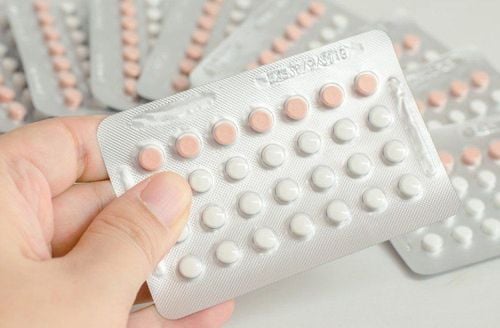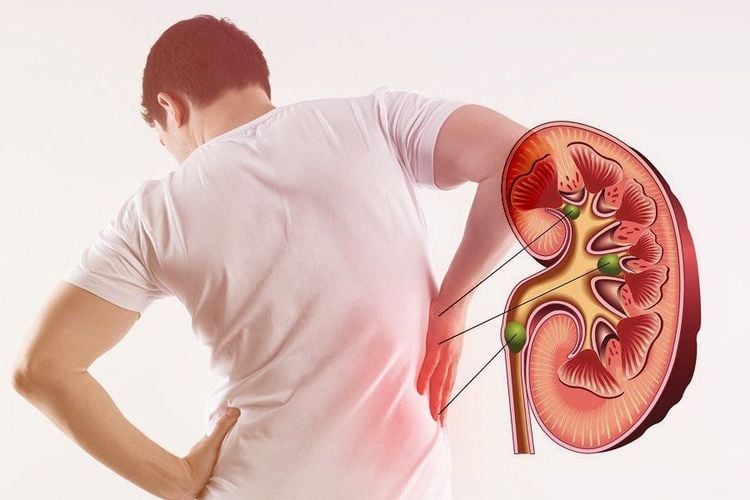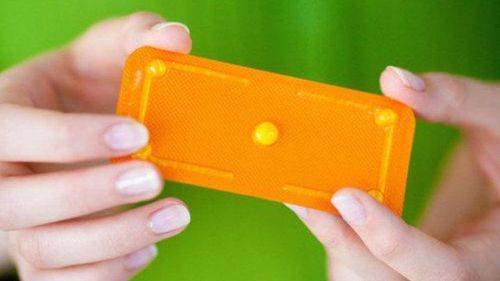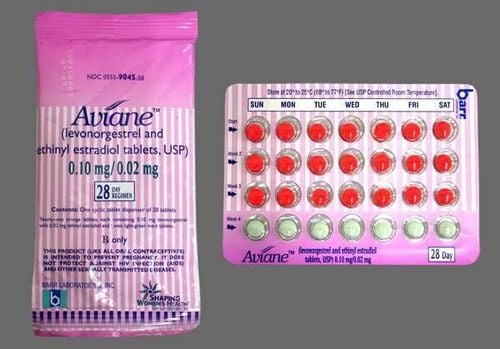This is an automatically translated article.
Currently, there are many highly effective birth control methods. In particular, the combined hormonal contraceptive pill is the choice that many women trust. One brand of birth control pill that can be found on the market is Loestrin. So what does Loestrin do?
1. What effect does Loestrin have?
What does Loestrin do? This is a hormonal contraceptive that combines a hormone progestin and an estrogen hormone. The main effect of the drug is to inhibit the ovulation process in the female menstrual cycle. In addition, some other side effects that increase the effectiveness of contraception include: thickening of vaginal fluid to help prevent sperm from meeting an egg (fertilization); changes the lining of the uterus to prevent a fertilized zygote from implanting. If the fertilized egg with sperm does not attach to the lining of the uterus, it will be eliminated from the body.
Besides preventing pregnancy, the drug Loestrin also has the following effects:
Regulate the menstrual cycle more evenly, reduce menstrual blood and abdominal pain during menstruation; Reduce the risk of ovarian cysts; Treatment of acne. Users should note that Loestrin is not able to protect the body from sexually transmitted diseases (such as HIV, gonorrhea, chlamydia).
2. How to use Loestrin
Users need to refer to the medication instructions on the package or provided by the pharmacist, this is very important to guide the user about when to take the medicine and what to do if a dose is missed .
Loestrin is to be taken by mouth, as directed on the package or as directed by your doctor, usually once a day. Choose a convenient, easy-to-remember time and take Loestrin at the same time each day.
The bottom line when using the hormonal birth control pill Loestrin is to keep taking it exactly as directed. Different brands of birth control pills will have different levels of estrogen and progestin in each pill depending on when in the cycle. Therefore, the user needs to follow the instructions carefully to find the first active pill and take it, then take the remaining pills in the correct order, without skipping any Loestrin pills.
The possibility of pregnancy will occur when the user misses Loestrin pills, then start a new pack of pills at another time of day and keep taking the pill regularly at this time.
Vomiting or diarrhea is a factor that can reduce the effectiveness of oral contraceptives (including Loestrin). If vomiting or diarrhea occurs, the user needs to use an additional backup method of birth control (such as condoms, spermicide).
Taking Loestrin after dinner or before going to bed can be helpful for people with stomach upset or nausea caused by the drug. Regardless of the dosing schedule used, the most important thing is to take Loestrin at the same time every day, 24 hours apart.
Loestrin packs include 21 active (hormonal) pills and sometimes 7 inactive reminder pills. Users take one active pill once a day for 21 consecutive days and take the remaining 7 inactive pills once a day for the next 7 days (for a pack of 28 pills).
Users should note that if the Loestrin package contains only 21 pills, do not take any pills for 7 days after the drug is gone, unless otherwise directed by the doctor.
Users will usually get their period in the fourth week of the cycle. After completing the above cycle, the user should start a new pack of pills the next day whether menstruation or not. If there is no period, consult your doctor.
If this is your first time using Loestrin and you are not switching from another form of hormonal contraception (such as the patch, another pill), take the first pill in the pack on the day of the first day. the first day after the start of your menstrual cycle or on the first day of your period.
For the first Loestrin cycle, users should apply an additional form of non-hormonal birth control (such as condoms, spermicide) for the first 7 days to increase contraceptive effectiveness and wait for Loestrin enough time to take effect.
If started on the first day of the period, the user may not need to use backup contraception during the first week.
Consult your doctor or pharmacist about switching from other forms of hormonal birth control (such as the patch, other birth control pills) to the Loestrin medicinal product.

Thuốc Loestrin cần được sử dụng đúng theo kê toa của bác/dược sĩ
3. Side effects of the drug Loestrin
Loestrin may cause nausea, vomiting, headache, abdominal bloating, tightness in the chest, swollen ankles, swelling in the feet (due to fluid retention) or weight changes. Users may experience vaginal bleeding between periods (spotting) or missed periods, irregular periods, especially during the first few months of using Loestrin.
If any side effects of Loestrin persist or get worse, tell your doctor or pharmacist immediately.
If the user of Loestrin is late for 2 periods in a row (or 1 period if Loestrin has not been used correctly), contact your doctor for a pregnancy test. Loestrin can increase a person's blood pressure, so it's important to check your blood pressure often and let your doctor know if the results are high. Serious side effects of Loestrin that need to be reported to your doctor right away include:
A lump in the breast; Mental changes (new or worsening depression); Stomach pain, severe abdominal pain; Abnormal vaginal bleeding (continuous bleeding, sudden heavy bleeding, missed period); Dark urine ; Yellow eyes, yellow skin. Loestrin can rarely cause serious (fatal) problems with blood clots (such as deep vein thrombosis, heart attack, pulmonary embolism, stroke). However, the patient should note signs such as:
Chest pain, jaw pain, sometimes pain spreading to the left arm; Confusion; Dizziness, or sudden fainting; Pain accompanied by swelling and heat in the groin or in the calf; Difficulty speaking, sudden shortness of breath, rapid breathing; Unusual headache (including lack of coordination, migraine, sudden severe headache); Unusual sweating; Weakness on one side of the body; Changes in vision (double vision, partial blindness, or complete blindness). Very serious allergic reactions to Loestrin are very rare. However, seek medical help immediately if the user notices any symptoms of a serious allergic reaction including: rash, itching, swelling of the face, swelling of the tongue, dizziness, trouble breathing.

Thuốc Loestrin có thể gây ra triệu chứng đau dạ dày
4. Notes when using the drug Loestrin
Before using Loestrin, tell your doctor or pharmacist if you have a history of being allergic to any estrogen (such as ethinylestradiol, mestranol) or any progestin (such as norethindrone, desogestrel) or have any other allergies.
Before using Loestrin, tell your doctor or pharmacist your medical history, especially of:
Blood clots (in legs, eyes, lungs...); Blood clotting disorders; High blood pressure; Abnormal breast exam results; Cancer; High cholesterol levels; Depression; Diabetes; Family or personal history of angioedema; Gallbladder problems; Headache , migraine ; Heart problems (valvular disease, irregular heartbeat, previous heart attack); History of yellowing of the eyes or skin during pregnancy or while using hormonal contraception; Kidney disease; Liver failure; Stroke ; Swelling edema; Thyroid problems ; Unexplained vaginal bleeding. If the person taking Loestrin has diabetes, Loestrin can affect blood sugar levels, so it's important to check your blood sugar as often as directed and share the results with your specialist. Note symptoms of hyperglycemia such as increased thirst, increased frequency of urination. It may then be necessary to adjust your diabetes medications, exercise program, or diet.
Tell your doctor if you are taking Loestrin moderately/will have surgery, or are about to sit in bed/chair for a long time (such as a long flight)... these conditions increase the risk of blood clots forming , especially if the user is taking hormonal birth control . People taking Loestrin may then need to stop taking it for a while or take other special precautions.
Loestrin may cause darkened areas of the face (melasma). The sun will make this condition worse, so limit time in the sun, use sunscreen, and wear protective clothing.
It may take longer to get pregnant after you stop taking Loestrin. Accordingly, Loestrin should not be used during pregnancy. If the person taking Loestrin becomes pregnant or suspect that you are pregnant, tell your doctor right away. For mothers who have just given birth or have had a miscarriage/abortion in the last 3 months, consult your doctor about other reliable forms of birth control and find out when is the safest time. to start using birth control that contains a form of estrogen such as Loestrin .
Loestrin may decrease breast milk production. Small amounts of Loestrin may pass into breast milk and cause unwanted effects in a nursing infant.

Người bệnh thận nên lưu ý khi dùng thuốc Loestrin
5. Loestrin drug interactions
Drug interactions can change the way Loestrin works or increase your risk of serious side effects. Some products that may interact with Loestrin include:
Aromatase inhibitors (anastrozole, exemestane); Ospemifene; Tamoxifen; Tizanidine; Tranexamic acid; Combination product used to treat chronic hepatitis C. Some medications can make hormonal birth control (such as Loestrin) less effective by reducing the amount of birth control hormone in the body, which can lead to pregnancy, such as:
Griseofulvin; Modafinil; Rifamycins; seizure medicine (barbiturates, carbamazepine, felbamate, phenytoin, primidone, topiramate); HIV medicines (such as nelfinavir, nevirapine, ritonavir). Let your doctor know when you're starting any new medication and discuss whether additional reliable birth control should be used.
Also, people taking Loestrin should let their doctor know if there are any spotting or sudden bleeding, which could be signs that Loestrin birth control is not working as well.
Loestrin drug can interfere with some tests such as blood clotting factors, thyroid... causing false test results. Symptoms of Loestrin overdose may include severe nausea and vomiting, and sudden vaginal bleeding.
Loestrin users should have regular physical exams, including tests such as blood pressure, breast exam, pelvic exam, and cervical smear to monitor and check for Loestrin side effects. . It is especially important to examine the breasts and report any lumps immediately to the doctor.
Refer to the information on the Loestrin product package for information on the missed dose. Users may need to use backup birth control (such as condoms, spermicide) to prevent pregnancy.
If you frequently forget to take your Loestrin pill as directed, contact your doctor to switch to another form of birth control. Store Loestrin at room temperature, away from light, moisture, do not store Loestrin in the bathroom, keep it away from children and pets. Do not flush Loestrin down the toilet or down the drain, dispose of it appropriately when it has expired or is not needed.
Please dial HOTLINE for more information or register for an appointment HERE. Download MyVinmec app to make appointments faster and to manage your bookings easily.
Reference source: webmd.com













